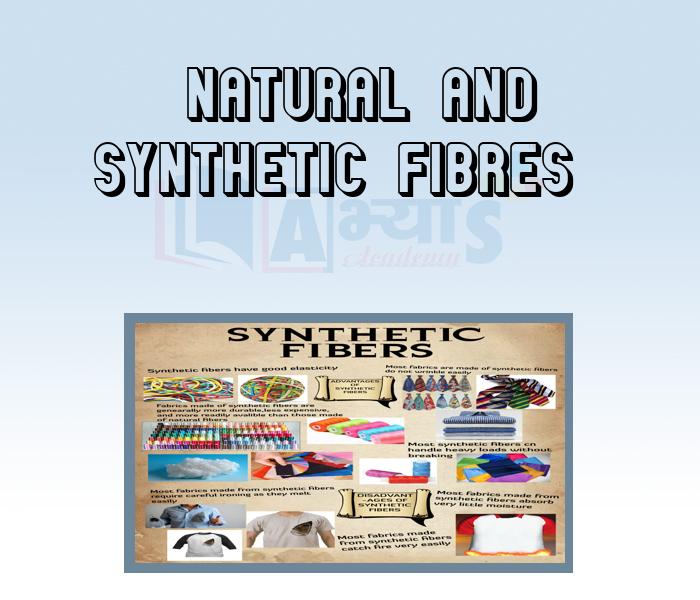Natural And Synthetic Fibres


Natural And Synthetic Fibres
Natural And Synthetic Fibres:
Natural Fibres: Cotton, wool and silk are three important natural fibres, which are used in making fabrics. Cotton is a cellulose fibre, whereas wool and silk are protein fibres. Cellulose is a naturally occurring polymer found in the cell wall of the plants.
Synthetic Fibres (Man-Made Fibres): These are of two types:
(i) Those which are made from natural raw materials, e.g. rayon;
(ii) Those which are purely synthetic and do not require any natural raw materials, e.g. nylon and terylene.
Rayon: This is a man-made silk, which consists of purified cellulose in the form of long fibres. Rayon fibre is chemically identical to cotton but has a shine like silk and, hence, called artificial silk. Basically, derived from a renewable source, it is called a regenerated fibre. Rayon is used on a large scale in India for making textiles, tyre-cord, carpets and surgical dressing.
Nylon: Nylon was the first synthetic fibre made by man. Today it is used for a variety of purposes where high strength fibres are required, such as fishing nets, ropes, parachute fabrics and tyre-cord. It is also mixed with wool to make long lasting fabrics. Nylon is widely used as a plastic for making machine parts.
Polyester: Since this fibre contains many ester groups, it is called Polyester.
Polyester fibres, like nylon, absorb very little water, Clothes made of polyester, therefore, dry quickly. The fibre retains crease and lasts for a long time. Polyester fibres are widely used in the manufacture of textiles - sarees, dress materials and curtains. They are mixed with natural fibres for making blended textiles. Polyester is used for making sails for sail boats, and a variety of other materials such as water hoses, for fire fighting.
Carbon Fibres: Carbon fibres made of long chains of carbon atoms possess high strength and resistant to corrosion. They are made from regenerated or synthetic fibres by heating them in the absence of oxygen. Thereupon, the fibres decompose to produce carbon fibers. Carbon fibres are used in spacecraft and for making sports goods.
Students / Parents Reviews [10]
It was good as the experience because as we had come here we had been improved in a such envirnment created here.Extra is taught which is beneficial for future.

Eshan Arora
8thAbhyas Methodology is very good. It is based on according to student and each child manages accordingly to its properly. Methodology has improved the abilities of students to shine them in future.

Manish Kumar
10thIt was a good experience with Abhyas Academy. I even faced problems in starting but slowly and steadily overcomed. Especially reasoning classes helped me a lot.

Cheshta
10thMy experience with Abhyas academy is very good. I did not think that my every subject coming here will be so strong. The main thing is that the online tests had made me learn here more things.

Hiya Gupta
8thMy experience with Abhyas is very good. I have learnt many things here like vedic maths and reasoning also. Teachers here first take our doubts and then there are assignments to verify our weak points.

Shivam Rana
7thAbout Abhyas metholodology the teachers are very nice and hardworking toward students.The Centre Head Mrs Anu Sethi is also a brilliant teacher.Abhyas has taught me how to overcome problems and has always taken my doubts and suppoeted me.

Shreya Shrivastava
8thA marvelous experience with Abhyas. I am glad to share that my ward has achieved more than enough at the Ambala ABHYAS centre. Years have passed on and more and more he has gained. May the centre flourish and develop day by day by the grace of God.

Archit Segal
7thOne of the best institutes to develope a child interest in studies.Provides SST and English knowledge also unlike other institutes. Teachers are co operative and friendly online tests andPPT develope practical knowledge also.

Aman Kumar Shrivastava
10thMy experience was very good with Abhyas academy. I am studying here from 6th class and I am satisfied by its results in my life. I improved a lot here ahead of school syllabus.

Ayan Ghosh
8thI have spent a wonderful time in Abhyas academy. It has made my reasoning more apt, English more stronger and Maths an interesting subject for me. It has given me a habbit of self studying
